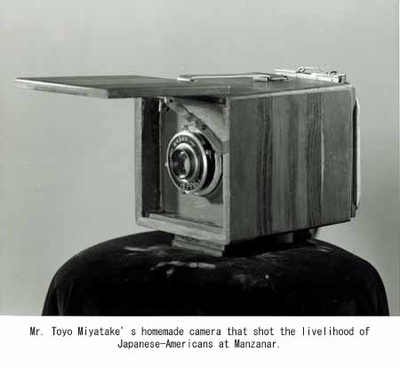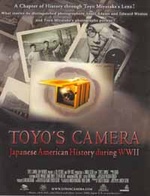On January 29, at the Japan Foundation in downtown Los Angeles, a screening for a documentary called “Toyo’s Camera” took place. This movie was produced and directed by Junichi Suzuki who made his name in Japan and moved to America after getting his green card.
For director Suzuki who had immigrated to the United States 7 years ago, hearing Japanese Americans talk about their internment experience is something he had no chance of getting to know in Japan. In actuality, it seems the Japanese are not so interested in fellow Japanese that have left the country to go overseas. He does not even recall learning about “overseas emigration” in school during Social Studies time. The author learned about Japanese Americans watching NHK’s “Two Mother Countries (Futatsu No Sokoku)” and, after that, seeing “Come See The Paradise” by Britain’s Sir Alan William Parker. By the way, the title is translated into Japanese as “Traveling the Road of Love and Sadness,” but the original English title is indeed “Come See The Paradise.” The story is about Japanese Americans that were forced into internment camps, so while watching this movie, I thought how the title of ‘come and play in paradise’ has such a twist of irony.
Going back to “Toyo’s Camera,” Mr. Toyo Miyatake, who was forced into the Manzanar Concentration Camp during World War 2, brought with him a homemade camera and secretly shot living conditions. He felt it was his responsibility to leave a record of such an experience in the form of photography. Through such works as that of Mr. Toyo’s, director Suzuki decided to convey such Japanese American circumstances during the war in the form of a movie. He also obtained a lot of testimony from Mr. Archie Miyatake, father of Mr. Toyo Miyatake, who also served as his assistant. One day, Manzanar’s camp director called for Mr. Toyo. Mr. Toyo thought his secret photo sessions had been discovered. However, because the director’s friend was the famous photographer Edward Weston, the director was understanding of Mr. Toyo’s activities and allowed him to open a studio inside the internment camp. However, he forbade Mr. Toyo himself to take the pictures.
How were living conditions within the internment camp? From Mr. Toyo’s works, as well as works of Ansel Adams who had later taken photos at Manzanar, we can see that the Japanese Americans lived unperturbedly. Those images are a far cry from that of the Japanese living in poverty in Japan during the war. However, we should not compare this with Japan. Even if their parents were born in Japan, the youngsters and children that were interned were born in America and are United States citizens. We should be comparing their circumstances with those children that were born in America as well.
In addition, the movie goes on to tell accounts of letters of those that were interned who pledged their faith to the United States, the clash of pro-Japanese (many returned to Japan) vs. pro-United States, and expedition troops such as the 442nd Regimental Combat Team that fought in Europe. The title is “Toyo’s Camera,” but as the director had said during a press conference, this is not an autobiography of Mr. Toyo’s. Using Mr. Toyo’s photographs as clues, this movie illustrates the “circumstances of Japanese-Americans during the war” and also focuses on the “after effects” of such an experience.
At the end of the movie, on several street corners in Japan and in America, the movie asks people if “they know that the Japanese-Americans had been forced into internment camps.” It seems Americans know more about this than the Japanese. One Japanese person that was interviewed in Tokyo said, “Are you talking about the Jewish people of Germany that were forced into internment camps?” making a wrong guess. What is important is that we let more people know about this fact. If you do not know historical facts, then there will be no interest. If there is no interest, we cannot avoid similar incidents in the future.
Unless the Japanese Constitution is re-written, there is no possibility of Japan and America becoming enemy countries again. However, a friend of the author’s who also has a son born in the United States making him a second generation Japanese, said this. She is someone that has interest in knowing about the Japanese-American internment issue during the war. “What if we have another war? What if our children who play with the other White, Hispanic, African-American and other Asian kids at school happen to be forced into separation and sent to internment camps? As Japanese parents that are born in Japan, we might think, ‘that cannot be helped,’ but I cannot agree with our children having to face the same circumstance.” If you place yourself in their shoes, you can easily understand how unfair their treatment was at that time.
***Theatre Information***
U.S.A.
Los Angeles
3/6(Fri)-12(Th): Laemmle Monica?Plex
Show Time (4Times/Day)
*Special Screening in Japanese on 12th
3/15(Sun):Aratani Theatre (JACCC)
Show Time (11am/2pm/5pm)
*Special Screening in Japanese at 5PM
*Advance Ticket $7 / General $10
JAPAN
Tokyo
4/11(Sat) - : Tokyo Metropolitan MOP
*Advance Ticket ?1,200 / General ?1,800
Yokohama
4/25(Sat): Jack & Betty
*Advance Ticket ?1,200 / General ?1,800
Website: www.toyoscamera.com
© 2009 Keiko Fukuda








